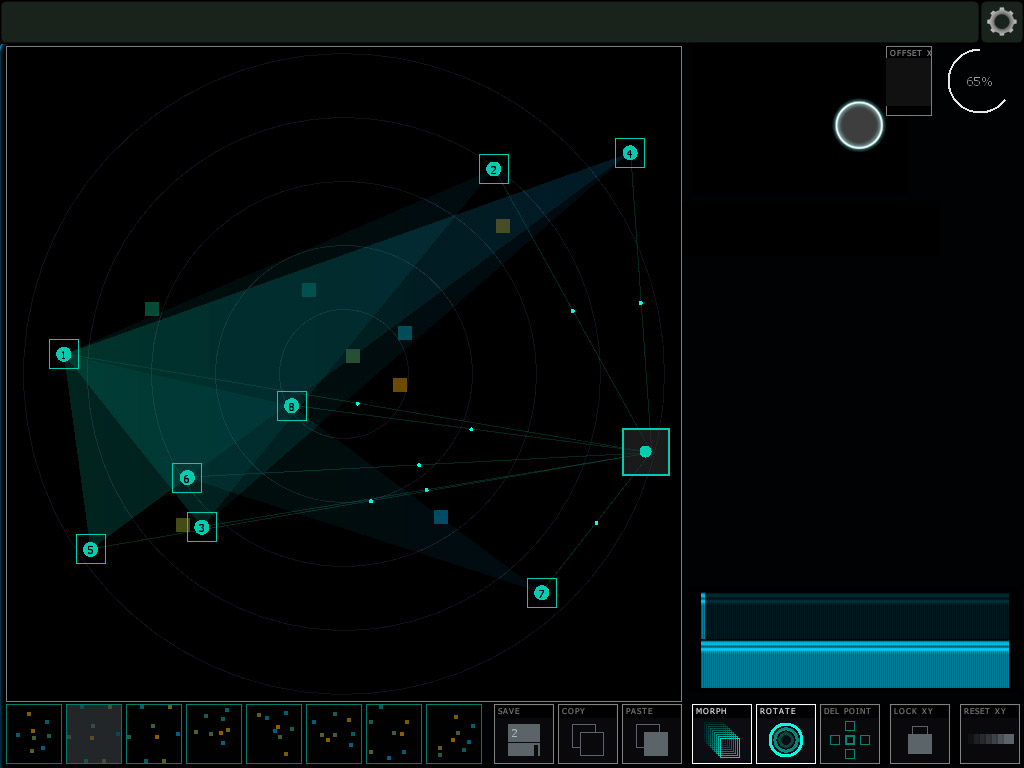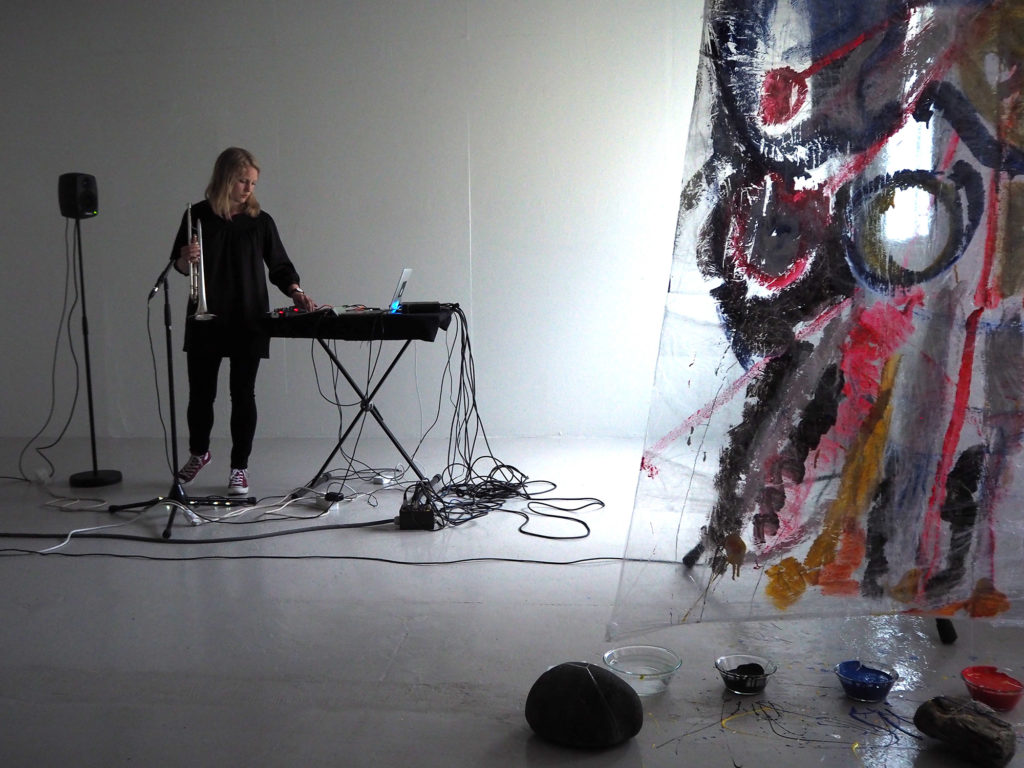Interview: Hilde Marie Holsen

Ultima Oslo contemporary music festival
Marmorsalen, 11th of September 7PM
Natasha Barrett: Involuntary Expression (WP)
Eliane Radigue: Arthesis
Hilde Marie Holsen: Prikle (WP)
Are you a composer, sound artist; what do your work convey?
A sound artist, perhaps? My electronic setup is developed with the trumpet, and is colored by the trumpet sound, the overtones and how the different sounds in the instrument behave. I do not use any other recordings, samples or audio sources when I play a concert, only what I get out of the trumpet, and the effects, that day. I’m looking at ways to expand my sound image, and use the instruments to color, and to destroy and rebuild each other, depending on what role I give the trumpet or effects from time to time. To me, technology and trumpet are fully interlaced.
How did you get into music technology?
It started with an interest in field recording at the upper level, most of which was an interest in how different sounds sounded when I could not see the source anymore. I could record the sounds frum rubbing a small plastic bag, sounds from the subway, the mountain, without any plans as to whether to use it for anything. It was only when I arrived at the conservatory and came across different music programs that I started working on electroacoustic music. I first got Ableton Live to pick a Clifford Brown solo. He plays quite fast, and in Ableton, you can slow down the pace without changing the pitch and I managed to hear what tones he were playing. Later I used some of the field recordings in Ableton, but I quickly went away for this. Now it feels like the use of field recording takes a focus or capacity that I would rather use to produce the sound at the moment. I’ve been working a lot to produce different types of qualities live, such as the sound of a train that slows: How can I get the trumpet to simulate or have that sound quality? Much of my work is to find the sound quality, find or recreate it in the trumpet and electronics together, instead of looking through a library of audio files that might start and end a bit funny, I can also make and shape the sound myself.
After three years specialization in rythmic music at the University of Agder, Hilde started at the Norwegian Academy of Music’s master in performing music technology, with Mats Claesson as study manager and Hild Sofie Tafjord + Maja Ratkje as supervisors. She took hours with Sven Erga, (who teaches Ableton Live for Notam), and our course in Max.
To me, the Max course was very fun because it was so specific. In improvisation, very little is, sometimes it’s just a “feel”, and you do not quite know what you have done. Learning to program and think logically was a sickly delicious opposite. I also found the collective SKRR (Anders Tveit, Eskil Muan Sæther, Magnus Bugge and Erik Strutz) who arranged programming evenings and Notam Forum, and that made me start hanging around at Notam. The first time I was here, there was a long table of laptops and programming evening, where we showed each other what we were doing. Everyone put on their very different skills. This was where I was made aware of Lemur, which I now use as one of my controllers. There were meetups once a month, and last time at the end of the season we played together to a silent movie.
You’ve played in a band and made various collaborations, Who are you playing with now and what’s your role?
I have been playing for two years with Magnus Bugge. In all my collaborative projects I enter as the musician I am, with my audio universe, the aesthetics are largely the same, but the sounds may be different because they adapt to the other. In the project with Magnus, it’s very funny how his synner goes so loudly and blends so well with my sounds and typically it’s hard to hear who’s what. Otherwise, there is often cooperation, examples may be with Stian Balducci, with SYNC and with Tyra Fure Brandsæther.
What are you searching for in sound?
I am trying to find different audio qualities in my setup, both in the electronic and in how I play the trumpet. I explore different audio records, and sound spectrum. My starting point is not very theoretical, and at the outset, I did not want to focus on the theory about how Ableton works, because I was a bit tired and felt it could soon be hampered by what others told was “proper” use. This made it important for me to use the ears to find out when I think the sound is good. There are a lot of sound engineers who have looked at my setups and set up a face like, “does she knows what she’s doing?,” but when I’m starting to play, it’s okay.
How do you integrate surrounding sound into the composition?
That’s what I’m working to figure out now. The contrasts that I work on get a different emphasis and become clearer because the location in the room adds to all. Distance makes you hear the sounds in a different way. I’ve worked on these things a lot with stereo. It’s the first time I’m working on surround sound, and i spent the inaugerate time here was just for learning and getting the sound under the skin and a feeling of what I like and do not like, how the sound is perceived when it’s moving and gets different placements. For long I was working on the technical without being in any artistic process, to orientate takes time as this is a new landscape. It is also very little used, stereo is a very internalized and familiar format. I’ve not been to a huge amount of concerts in surround sound, so I do not have many reference frames to base upon, so I need to be confident in my own way of doing it.
Do you think you will to continue your work in immersive sound?
Certainly, I hope to get there. It’s very exciting to find out how to create room and audio experiences with this technique.


Read Mischa Mathys’ interview with Hilde here:
https://theformant.info/off-the-score-a-qa-with-hilde-marie-holsen/
From the program of Ultima:
Hilde Marie Holsen combines trumpet and electronics, usually in an improvised setting. Acoustics and electronics play off each other, with melancholic sounds and melodic themes. This is a music of fragility, but equally of strength and dynamics. Prikle is a piece commissioned by Ultima for trumpet, live electronics and 3D surround sound, live performed and diffused via 24 loudspeakers by Holsen. “Prikle” is the Norwegian term for transplanting seedlings from the nursery to its permanent place of growth. In this piece, the various trumpet sounds act as sonic seedlings whose conditions for growth are enhanced by electronic processing.